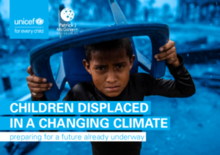Millions of children are being driven from their homes by weather- related events, exacerbated by climate change. While the link between climate change and displacement is complex, it’s clearer than ever that the climate is shifting patterns of displacement.
Displacement – whether short-lived or protracted – can multiply climate- related risks for children and their families. In the aftermath of a disaster, children may become separated from their parents or caregivers, amplifying the risks of exploitation, child trafficking, and abuse. Displacement can disrupt access to education and healthcare, exposing children to malnutrition, disease, and inadequate immunization.
Yet until now, children displaced by weather-related events have been statistically invisible. Existing displacement data are rarely disaggregated by age, and factors such as rapid urbanization, fragility and conflict can mean that children on the move are even more likely to slip through the cracks.
‘Children displaced in a changing climate: Preparing for a future already underway’ analyses the most common weather-related hazards that lead to the largest number of displacements: floods, storms, droughts and wildfires. The report notes that there were 43.1 million internal displacements of children linked to weather-related disasters over a six-year period – the equivalent to approximately 20,000 child displacements per day. Almost all – 95 per cent – of recorded child displacements were driven by floods and storms.
To improve outcomes for children and young people at risk of future displacement, the report calls on governments, donors, development partners and private sector to take the following actions:
- Protect children and young people from the impacts of climate change and displacement by ensuring child-critical services are shock-responsive, portable and inclusive, including for children already uprooted.
- Prepare children and young people to live in a climate changed world by improving their adaptive capacities, resilience and enabling their participation.
- Prioritize children and young people – including those already uprooted from their homes – in climate, humanitarian and development policy, action and investments.

